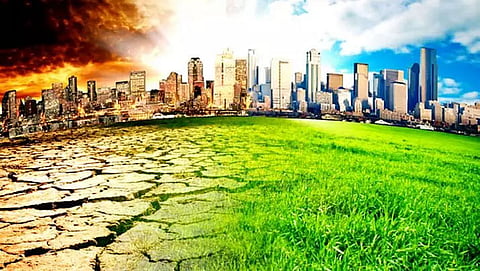
- Home
- Live Blog
- Breaking News
- Top Headlines
- Cities
- NE News
- Sentinel Media
- Sports
- Education
- Jobs

Rajbir Saha
(rajbirsaha1995@gmail.com)
In recent years, several parts of the world have experienced an increase in the number of heatwaves including the world major urban areas with the largest human populations. The global growth of heatwaves since the early 21st century is one of the most severe climatic threats for humanity. Anthropogenic emissions have most likely increased. The likelihood of existing heat waves and the predicted potential warming of the atmosphere is proving to increase the incidence of extreme heatwaves. It has made the intense heat waves and is projected to make heat waves even hotter and more frequent in the future. Prolonged exposure to very high temperatures can lead to thermal diseases, encompassing heat cramps, heat exhaustion, and heatstroke. It has been shown to increase heart attacks respiratory mortality and cardiovascular mortalities. Furthermore, hot weather has a significant worldwide effect on socio-economic setups, water uses, forest resources, and crop losses. The estimated result of these events is some 100,000 excess fatalities and several other human and ecosystem effects such as wildfires, crop failures and disruption and damage of infrastructure. These effects are also estimated to be associated with a range of human and environmental impacts. In India, heat waves almost annually cover certain parts of the country during the pre-Monsoon seasons (March-May) and result in a high mortality rate in large populations.
Extreme heat events have become a primary public concern, receiving increasing attention in the literature. These heat waves would be more intense, frequent, and prolonged in the future warming climate with a rising mean temperature. Scientists agree that longer and hotter heat waves are among the most certain impacts of climate change. The sustained record-breaking temperatures that have plagued certain regions of the world in recent years are a sign of a rapidly warming planet and a preview of how heat extremes will continue to intensify. Extreme heat threatens the lives and livelihoods of millions of people around the globe. It kills people, damages infrastructure, and exacerbates food insecurity. Developing nations and low-income communities frequently bear the brunt of extreme heat's impacts yet have the least resources to cope. There is growing recognition among policymakers, business leaders, and citizens that the world needs to adapt to withstand worsening heat. This aspect of the climate crisis will feature prominently in negotiations at this year's UN conference, the twenty-sixth Conference of the Parties (COP26), in November. The earth's average temperature has risen more than 1°C (1.8°F) since the 1880s due to soaring greenhouse gas emissions caused by human activity. Scientists say this higher level of heat has contributed to worsening weather extremes, including hotter and longer heatwaves and extended droughts. Some areas of the world are heating more rapidly, including the Arctic, which is warming at least twice as fast as the rest of the planet. More than one-fifth of the global population now lives in regions that have already experienced warming greater than 1.5°C (2.7°F), an increase that almost all nations have agreed should be avoided to significantly reduce the risk of harm from climate change. Even if global warming is limited to 1.5°C above preindustrial levels—the goal set in the Paris Agreement—thirty to sixty million people live in areas where the average temperature in the hottest month would be too high for a human body to function healthily.
However, the world is currently on a path that will take it high above 1.5°C: temperatures are estimated to exceed 3°C (5.4°F) of warming by 2100. Some regions, such as the Middle East, anticipate 4°C (7.2°F) of warming by 2050 if emissions continue unabated. By 2050, more than 70 per cent of people worldwide could experience severe heat waves. According to Columbia University's Earth Institute, global warming could kill as many as eighty-three million people over the next eight decades, a population equivalent to Germany's. One factor that contributes to more deaths is what is known as the wet-bulb temperature. Exposure to a sustained wet-bulb temperature of 35°C (95°F), a point of intense heat and humidity, has been identified as the limit for human survival. When wet-bulb conditions develop, sweat can no longer evaporate off a person's skin and the body cannot cool down. Just a few hours of this kind of heat exposure can lead to death. Extreme heat threatens the food security of billions of people by hampering crop production, livestock viability, and fishing sustainability. Yet, by mid-century, agriculture will have to produce nearly 50 per cent more food to feed the world's growing population. In the decades ahead, a changing climate will contribute to more frequent and more severe heat, even if emissions plunge to zero. Nations should rapidly reduce their emissions; meanwhile, governments, communities, and businesses have begun the essential task of adapting to these worsening heatwaves.
A clear place to start is increasing preparedness by creating heat adaptation plans. France has been a leader in this respect. Since an unprecedented heatwave in 2003 that killed nearly fifteen thousand people, France has become one of the world's most heat-prepared nations. Its National Heat Wave Plan, implemented the year after the heatwave, has cut the nation's death toll from heat waves by 90 per cent. Robust early-warning systems form a critical element of the plan: ahead of a heatwave, the government circulates posters, flyers, radio and TV campaigns, and internet ads to alert citizens of the impending heat and offer survival strategies. Early warnings based on accurate forecasts ensure that the population has ample time to prepare.